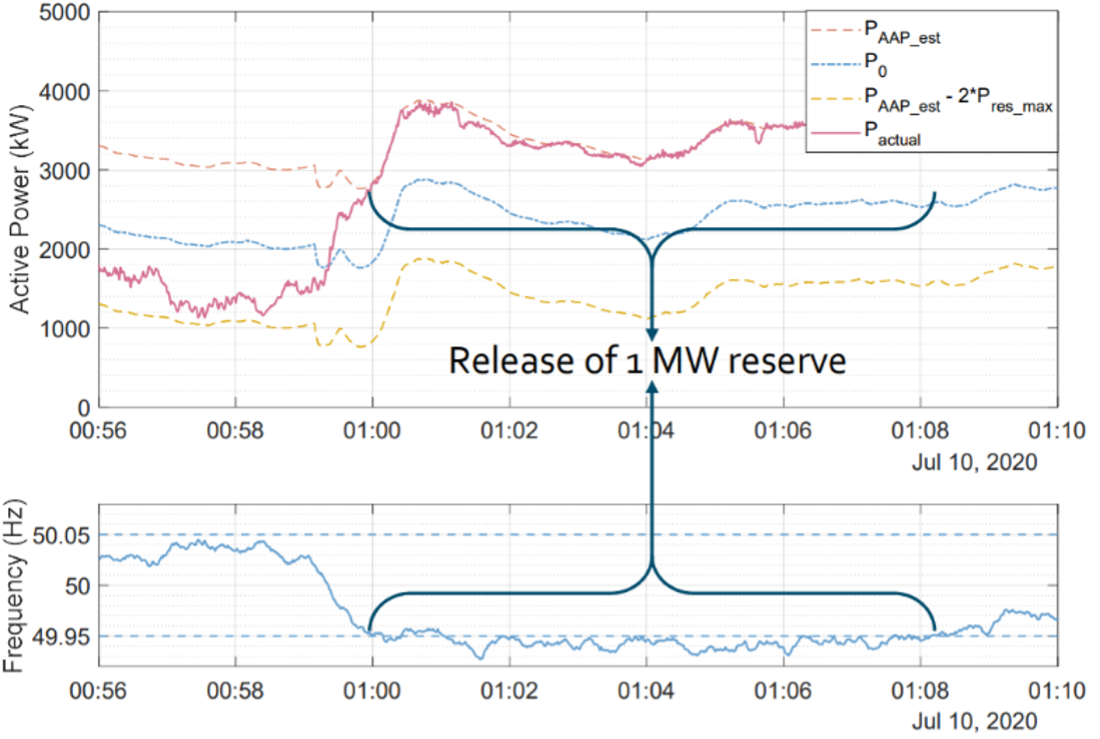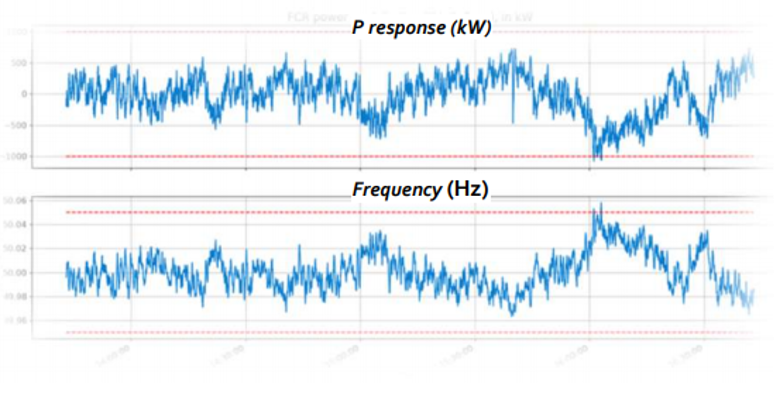EU-SysFlex French Virtual Power Plant: FCR provision by wind successfully demonstrated through local tests
25.03.2021News
In the previous published work related to the Work Package 8 (WP8) of the EU-SysFlex project, were shared the successful results of ‘multiple-services’ provision by a Battery Energy Storage System (BESS). Now, in turn and in the continuation of the WP8 demonstration work, another asset of the French Virtual Power Plant (VPP) was recently tested, which is the 12-MW wind farm, located in the department of “Marne” (about 120 km southeast of Paris). Comprising 6 x E82 2MW ENERCON wind turbines, the wind farm is in operation since 2015, and is supplying the equivalent of 5200 French households (~25000MWh/year).
FCR would be one of the next services to be provided by wind farms
If in some European Countries (i.e. Germany, Spain) wind farms can already participate to the provision of FRR (‘Frequency Restoration Reserve’), this is not yet the case for FCR (‘Frequency Containment Reserve’).
FCR is (for now) the first real time lever for ensuring the frequency stability of the Continental European Power System, and is provided so far mainly by the so-called dispatchable power plants. However, as such conventional generation is being displaced, it is a duty that Renewable Energy Sources (RES) should progressively take this service over.
The wind FCR provision was successfully demonstrated
Beforehand, to confer the tested wind farm with FCR capability, the wind farm local controller FCU (Farm Control Unit) was required to be upgraded with a specific power/frequency function. This function was carefully developed according to the “Frequency Sensitive Mode” (FSM) specified per the recent European Network Code on “Requirement for Generators” (RfG). The new function was implemented in the wind farm in Q1.2020.
The trial period started then in Q2.2020 and ended in Q3.2020, and was supervised by EDF in collaboration with ENERCON. The FCR controller was activated during several hours and the effective contribution of the wind FCR was also assessed by analyzing the active power output in response to the grid frequency measured.
One of the difficulties was that with typical FCR settings (i.e. full reserve released at ±200 mHz of frequency deviation), an observation period of several months would have been necessary to be able to observe and verify full wind reserve release.
To address this issue, a first phase of the tests consisted in using ‘provocative’ settings. The idea was to tune the controller more sensitive to smaller frequency deviations. This phase was aiming at proving the total available reserve, i.e. 1MW, when reaching ±50 mHz of frequency deviation, by respecting the dynamics of the response required by the RfG code.

In a second phase were used ‘realistic’ parameters, consistent with grid codes (±200 mHz for full reserve release). This phase was aiming at assessing the actual gain of the wind FCR response in a continuous manner, so as to evaluate the effectiveness of the reserve provision by a variable resource.

EDF analyzed the behavior of the windfarm during tens of hours. The results obtained show that wind farms can technically contribute to FCR in real conditions with requested performance: an excellent dynamic response was demonstrated and the actual FCR gain assessed is globally compliant with the current TSO’s requirements, even if in some rare occasions under-performance was observed during wind gusts.
Next steps
Following the successful experimentations on the wind farm (and previously on the storage system), the WP8 team is finalizing the set-up of the whole communication platform linking individual resources to the centralized VPP Energy Management System (EMS), and hopefully will start soon the operation of the full-chain VPP.
The detailed results and analyses of this work were presented at the “19th Wind Integration Workshop” in November 2020 and published in the workshop’s proceedings.
Written by:
Victor GOMES, ENERCON GmbH, Grid Integration Department, and Responsible for French and Belgium markets.
ENERCON has been one of the technology leaders in the wind power sector for more than 35 years. Its development is based on the vision of an “Energy for the world”, by creating sustainable, pioneering and future-proof renewable energy generation and supply concepts.
Dr. Ye Wang, EDF, WP8 leader of the EU-SysFlex project.
EDF is the largest producer of renewable electricity in Europe. Two priorities are at the heart of its research: preparing the flexible and adaptable electrical systems and grids of tomorrow, and consolidating and developing competitive and low-carbon energy generation mixes.
Disclaimer: blog entries reflect individual views of the author(s) that may not reflect official positions or communication of the project / project consortium.